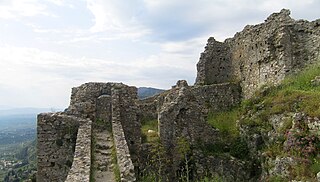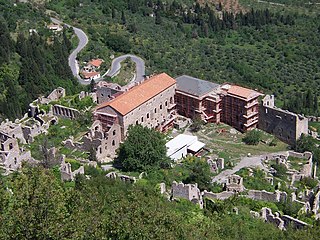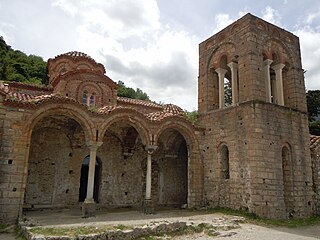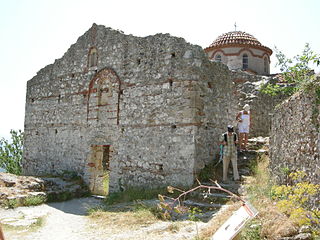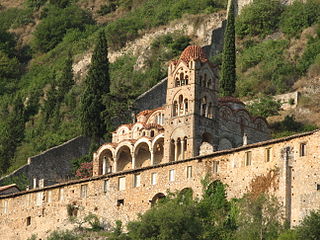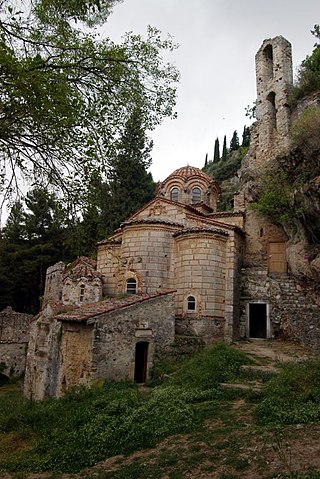Self-guided Sightseeing Tour #1 in Municipal Unit of Mystras, Greece
Legend
Tour Facts
1.3 km
323 m
Experience Municipal Unit of Mystras in Greece in a whole new way with our free self-guided sightseeing tour. This site not only offers you practical information and insider tips, but also a rich variety of activities and sights you shouldn't miss. Whether you love art and culture, want to explore historical sites or simply want to experience the vibrant atmosphere of a lively city - you'll find everything you need for your personal adventure here.
Individual Sights in Municipal Unit of MystrasSight 1: Villehardouin Castle
The Castle of Mystras is a Byzantine castle in Mystras, Greece. It is part of the wider archaeological site of Mystras, which is classified as a World Heritage Site by UNESCO.
Sight 2: Archaeological Site of Mystras
Mystras or Mistras, also known in the Chronicle of the Morea as Myzethras or Myzithras (Μυζηθρᾶς), is a fortified town and a former municipality in Laconia, Peloponnese, Greece. Situated on Mt. Taygetus, above ancient Sparta, and below a Frankish castle, it served as the capital of the Byzantine Despotate of the Morea in the 14th and 15th centuries, experiencing a period of prosperity and cultural flowering during the Palaeologan Renaissance, including the teachings of Gemistos Plethon. The city also attracted artists and architects of the highest quality.
Sight 3: Saint Sophia
The Church of Hagia Sophia or Holy Wisdom is a Byzantine church in the fortified medieval town of Mystras, Peloponnese, Greece. It forms part of the wider archaeological site of Mystras, which is designated as a World Heritage Site by UNESCO. Built within the palace complex, it functioned as the royal palace church until Ottoman conquest of Mystras and its conversion into an Islamic mosque. Hagia Sophia of Mystras was made back into a Christian church when Greece achieved independence during the early nineteenth century.
Sight 4: Saint Nicolas
The Church of Agios Nikolaos is a church of the post-Byzantine period in Mystras, Greece. It is part of the wider archaeological site of Mystras, which is classified as a World Heritage Site by UNESCO.
Sight 5: Pantanassa Monastery
The Pantanassa Monastery is a monastery in Mystras, Greece. It was founded by a chief minister of the late Byzantine Despotate of the Morea, John Frankopoulos, and was dedicated in September 1428. It is the only monastery on the site still permanently inhabited. Today it is inhabited by nuns providing hospitality. Its "beautifully ornate stone-carved façade" is of architectural note.
Sight 6: Μονή Περιβλέπτου
The Peribleptos Monastery is a late Byzantine-era monastery in Mystras, Greece. It was probably built in the mid-14th century by the first Despot of the Morea, Manuel Kantakouzenos, and named after one of the most celebrated monasteries of Byzantine Constantinople. The frescos in the main church, dating between 1348 and 1380, are a very rare surviving late Byzantine cycle, crucial for the understanding of Byzantine art. It is named after St. Mary of Peribleptos, of Byzantine, Constantinople (Istanbul). The Monastery is built into the side of a cliff with a cave supporting the structure. This architectural style is known as the "Mystras style" and is prevalent in several churches and monasteries in the area, this style is typified by a resemblance to a castle. It is constructed of squared stones with inlaid tiles. The complexity and unique variations of the shape of the structure of the exterior create an interior surface inside the monastery that lends itself to the ethereal quality of the frescoes covering the walls. These have been described as "delicate and subdued" in Byzantine Architecture and Decoration
Share
How likely are you to recommend us?
Disclaimer Please be aware of your surroundings and do not enter private property. We are not liable for any damages that occur during the tours.
GPX-Download For navigation apps and GPS devices you can download the tour as a GPX file.
